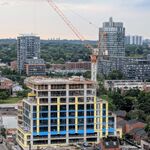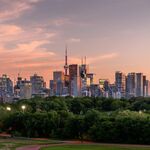sixrings
Senior Member
It would be expected that there would be more Caribbean people coming from the west of the station and Jews coming from the east of the station.
That's a fact not a hypothesis.
It would be expected that there would be more Caribbean people coming from the west of the station and Jews coming from the east of the station.
I live between bathurst and Eglinton west. I know the area which is why I'm confident that oakwood would see a lot of riders. Bathurst on the other hand are all benz suv owners. I'm less confident there despite thinking because is a major road it needs a stop.
Have you ever seen the crowds on the Bathurst bus? Like with at any other subway station, most riders arrive by bus, not by foot.
Have you ever seen the crowds on the Bathurst bus? Like with at any other subway station, most riders arrive by bus, not by foot.
Bloor and Bathurst yes. How many get on at lawrence and Bathurst to go south
Perhaps instead of saying "this line has seemingly been designed by NIMBYs" I should have said "this line has seemingly been designed by self-interested local residents who only care about how this line can serve them, even if it reduces the experience for everyone else (including them, unknowingly) in the aggregate" but that would've been too long.
I'm expecting we will come back to this debate a lot more heavily once planning of the DRL is underway, with people wanting quicker access to Union/King/St. Andrews from the Bloor line, and people who want more stations along the DRL.
The Neptis report (and seemingly you) treats the Eglinton line as only a means to funnel people to the Yonge line as quickly as possible. The Eglinton line with have more than one functionality as inhabitants of the central portion of the line (myself included) will treat the line as part of their community, as a means to reach local amenities, access local shopping areas and to travel seamlessly across Midtown without a car. It will be the catalyst for even greater densification, construction and commercial expansion through the entire central stretch of Eglinton, and not just at specific nodes along Eglinton ala the Sheppard line. This is what this part of the city hopes to realize in the long-term and why many 'self-serving local residents' have taken interest in this project.
I live between bathurst and Eglinton west. I know the area which is why I'm confident that oakwood would see a lot of riders.
The Neptis report (and seemingly you) treats the Eglinton line as only a means to funnel people to the Yonge line as quickly as possible. The Eglinton line with have more than one functionality as inhabitants of the central portion of the line (myself included) will treat the line as part of their community, as a means to reach local amenities, access local shopping areas and to travel seamlessly across Midtown without a car. It will be the catalyst for even greater densification, construction and commercial expansion through the entire central stretch of Eglinton, and not just at specific nodes along Eglinton ala the Sheppard line. This is what this part of the city hopes to realize in the long-term and why many 'self-serving local residents' have taken interest in this project. Inhabitants of Scarborough/Etobicoke won't care if whether Midtown realizes its potential or not, especially when it entails a lifestyle foreign to suburbia and marginally longer commute to Yonge-Eglinton station.
I'm expecting we will come back to this debate a lot more heavily once planning of the DRL is underway, with people wanting quicker access to Union/King/St. Andrews from the Bloor line, and people who want more stations along the DRL.
If any stop should be on the chopping block, it is Chaplin. While on paper Oakwood looks like it could go, the street itself benefits from mixed use and Caribbean culture. Chaplin on the other hand appears to be barely a collector road and seems like another Chester. Also note that there doesn't seem to be a stop between Mt. Pleasant and Bayview.
For the most part there really does need to be at least one stop between arterials in this city, they are too spaced out. Ironically if Glencarin was on the Yonge line rather than the Spadina end, it would be far more useful, as highway stretches of rapid transit are where it should run with fewer stops. For obvious reasons.
Admittedly my condemning of Chaplin is based on paper assumptions. If it is one of the busier stops along the route, along with those in its vicinity then it should be kept.
I don't think you can justify $200 million underground stations at Oakwood, or one of Chaplin or Avenue Road. These are walk-on only stations (very little connection to surface routes) that only benefit the surrounding community, and these are communities that have neither the density nor will to densify to a point that will lead to a sustainable demand for the station. For the extra $400 million + annual operating costs, you can run a frequent, parallel bus service along Eglinton or even build a streetcar line to serve local trips and operate it for the forseeable future.
The DRL alignment from Pape or Donlands probably only lends itself to only four stations or so between Danforth and Downtown especially as it doesn't directly replace a surface transit route: (These locations are approximate) Carlaw/Gerrard, Queen/Broadview, Parliament/Distillery District/Corktown and Sherbourne/Jarvis/Market. That reduces the number of stops from 10 or 11 + direct subway transfer to 4 + direct subway transfer to get to the Financial District from Danforth. To the north of Danforth, I'd only set up stops at Cosburn, Thorncliffe Park, Don Mills/Overlea area and Eglinton/Don Mills.
I think Eglinton-Crosstown is a bit more of a local route than the DRL should be.
Eglinton is one of Toronto's primary east-west routes and whether we like it or not it'll see significant automobile traffic. One of the benefits of building a subway here is that it will remove buses from Eglinton (typical morning rush hour rows of 6-7 buses stuck at intersections) and reduce traffic congestion.
Operating a parallel bus service (not mentioning a St. Clair-esque streetcar) defeats this gain. Especially since the current subway plan entails reducing a lane on Eglinton already.




